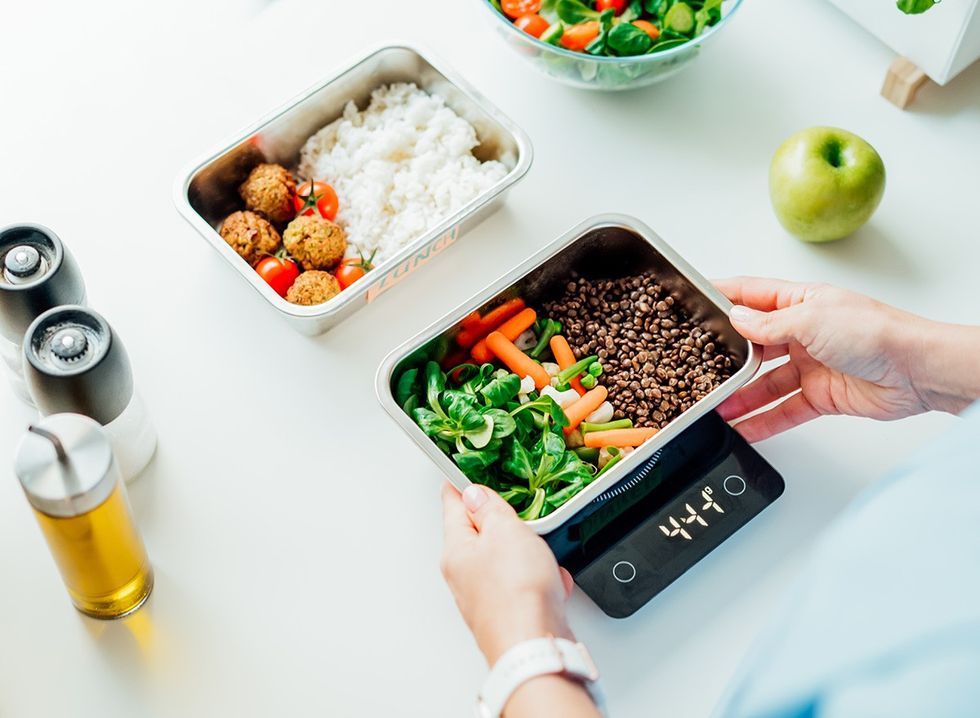Before nutritionists were experts, they were average people with less knowledge about food and diets. Shana Spence, MS, RDN, CDN (@thenutritiontea) is a non-diet focused nutritionist and social media influencer who shares realistic tips and tricks to help people become the healthiest versions of themselves. In a new viral video, she opens up about some of the mistakes she made before getting credentialed.
“Five things I would never do after becoming a dietician,” she says at the start of the clip. From putting labels on certain types of foods to making assumptions about people that aren’t true, here are the mistakes she made so you don’t have to – and we also asked The Diet Diva, Tara Collingwood, MS, RDN, CSSD, LD/N, ACSM-CPT, a Board Certified Sports Dietitian, to add her own commentary to the discussion.
Categorize Foods as “Good and Bad”
@thenutritiontea We learn these tactics in school and it’s our job to unlearn them #dietitiantips #dietitian #dietitiansoftiktok #blacktiktok #blackdietitian #allfoodisgoodfood #goodfoodgoodmood #5thingschallenge #healthyliving
First up, Spence would never “categorize foods as good and bad,” she says. “Not every food is meant to provide nutrients, and not every food is going to be providing the same nutrient. That's why we eat a variety of foods. And yes, some foods are providing us with joy and comfort. That's okay.” Collingwood completely agrees.
“I try not to classify foods as good and bad but rather need vs want,” she explains. “Foods that we need have nutritional value, while want foods have fewer nutrients. Eating a healthy diet is a balance of getting the nutrients we need for good health but also enjoying some of the others.”
Assuming Someone Is Unhealthy Based on Their Body

The second is making the assumption “someone is unhealthy based on their body,” she explains. “Bodies are not business cards. If we're talking about health based on lab values or whether someone is eating nutrient dense foods or getting in more movement, a lot of folks in larger bodies are doing those things and have great lab values. And on the opposite spectrum, a lot of folks in thinner bodies don't have great lab values and don't eat nutrient foods or get in a lot of movement,” she points out.
“You cannot just look at someone and know much about their overall health,” agrees Collingwood. “Some of the fittest people are in larger bodies with really good health measures. And just because someone is thin doesn’t mean they are automatically healthy. They could have very little muscle mass and have high blood pressure, cholesterol, and glucose levels.”
Related: Courteney Fisher Shows Off Washboard Abs and Reveals 5 Ways to Get to Blast Belly Fat
Healthify Foods

She also regrets trying to “healthify foods,” she says. “The time and Energy I spent making black bean brownies or ice cream when I could have just enjoyed ice cream and brownies. If you want to swap out something or if you're interested in trying out a new recipe, that's fine, but feeling the need to do something based on what you read on the interwebs is something different.”
Collingwood thinks making recipes healthier is a good thing, “but definitely not all the time,” she says. :If you really want some full fat ice cream, chocolate or a warm chocolate chip cookie, do it!”
Telling People to Stop Eating Their Cultural Foods

“Number four, telling folks to swap out white rice for brown rice in their cultural foods,” she continues. “My ancestors were probably rolling in their graves when I did this. Not to mention this is based on the whole idea that certain cultures and ethnicities are unhealthy.”
Some food swaps “can make a huge difference in calories or nutritional quality and some don’t really matter much,” says Collingwood. “When it comes to rice, there isn’t a big difference between white and brown, but for people who love their white rice it can ruin it for them. There are plenty of other places in the diet where you can make changes without needing to change everything, especially the cultural favorites.”
Related: 4 Easy Tips to Lose Weight, According to Dietitian
Only Shopping the Perimeter of the Store

“And last but not least, number five, telling people to shop the perimeter of the store,” she says. “Never. Again. This is based on the concept that fresh is best and clean. Eating, no such thing. There are plenty of nutrients found in canned foods, packaged foods, and frozen food. If you like the taste of fresh, that's fine, but telling someone that how they're eating is wrong because they choose foods from a can or package is elitist.”
Collingwood “never did like this advice either,” she says. “Sure, the perimeter has some fresh stuff, but the middle of the store has whole grains, beans, canned veggies, etc. In today’s world it’s not realistic that people won’t be using convenience foods and there isn’t anything wrong with it!”
💪🔥Body Booster: When it comes to everything surrounding diet and nutrition, it isn’t all black and white and you don’t have to go to extremes. Shop the middle of the store, eat the cookie or the rice, and don’t categorize things as good or bad. And if you enjoyed this article, take advantage of these 15 Quick Ways to Lose Body Fat Percentage in a Week.















 Shutterstock
Shutterstock Shutterstock
Shutterstock Shutterstock
Shutterstock Shutterstock
Shutterstock Shutterstock
Shutterstock Shutterstock
Shutterstock Shutterstock
Shutterstock Shutterstock
Shutterstock Shutterstock
Shutterstock Shutterstock
Shutterstock
 Shutterstock
Shutterstock Shutterstock
Shutterstock Shutterstock
Shutterstock Shutterstock
Shutterstock Shutterstock
Shutterstock


 I'm a Nutritionist and These 9 High-Protein Snacks Keep My Clients Full While Losing 50 Pounds
I'm a Nutritionist and These 9 High-Protein Snacks Keep My Clients Full While Losing 50 Pounds
 Shutterstock
Shutterstock 2. Processed FoodsShutterstock
2. Processed FoodsShutterstock Shutterstock
Shutterstock Shutterstock/Prostock-studio
Shutterstock/Prostock-studio Shutterstock
Shutterstock Pro TipsShutterstock
Pro TipsShutterstock Shutterstock
Shutterstock Shutterstock
Shutterstock Shutterstock
Shutterstock Shutterstock
Shutterstock Don’t Drink as Much AlcoholShutterstock
Don’t Drink as Much AlcoholShutterstock Most Women on GLP-1s Are Making a Few Common MistakesShutterstock
Most Women on GLP-1s Are Making a Few Common MistakesShutterstock Soda and Sugary DrinksShutterstock
Soda and Sugary DrinksShutterstock Shutterstock
Shutterstock Eat BreakfastShutterstock
Eat BreakfastShutterstock And Improve Insulin SensitivityShutterstock
And Improve Insulin SensitivityShutterstock Belly Flab Strip Tip: Sugar and Fat Calories Leave Its Mark on Your BodyShutterstock
Belly Flab Strip Tip: Sugar and Fat Calories Leave Its Mark on Your BodyShutterstock Shutterstock
Shutterstock The Drugs Mimic the GLP-1 Hormone Naturally Produced by the BodyShutterstock
The Drugs Mimic the GLP-1 Hormone Naturally Produced by the BodyShutterstock 3. Deep-Fried ItemsShutterstock
3. Deep-Fried ItemsShutterstock